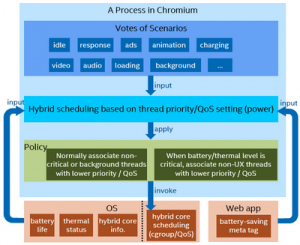According to the usage statistics of user application from Microsoft, 60% of the time people spend on the PC is within the web browser. Google Chrome is a cross-platform web browser developed by Google based on Chromium project. According to StatCounter website stats, by January 2022, the market share of Chrome browser is over 63% across all platforms worldwide.
Hybrid core architecture combining high performance cores and power-efficient cores became more and more popular, especially after Intel launched the Alder Lake CPU product. Performance cores are designed to provide maximum compute performance, while efficient cores are designed for maximum power efficiency. Usually OS schedulers can manage hybrid core scheduling, but they lack details of application behaviors, like critical paths. It’s difficult for OS schedulers to cover all scenarios.
We come from the Web Optimization team, and focus on power and performance optimization for Web platforms, mainly Chromium, aiming for better user experience on IA. This article introduces our work to utilize hybrid core capability to schedule specific threads/processes’ execution in Chrome browser to efficient cores, which adopts dynamic policies to reduce power consumption on different levels based on device state. All the analysis and tests below are performed on the Chrome OS platform.

